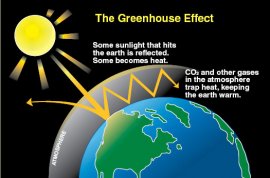Climate change because of global warming
Climate includes patterns of temperature, precipitation, humidity, wind and seasons. "Climate change" affects more than just a change in the weather, it refers to seasonal changes over a long period of time.
Climate patterns play a fundamental role in shaping natural ecosystems, and the human economies and cultures that depend on them.
Because so many systems are tied to climate, climate change can affect many related aspects of where and how people, plants and animals live, such as food production, availability and use of water, and health risks.
For example, a change in the usual timing of rains or temperatures can affect when plants bloom and set fruit, when insects hatch or when streams are their fullest. This can affect historically synchronized pollination of crops, food for migrating birds, spawning of fish, water supplies for drinking and irrigation, forest health, and more.
Some short-term climate change is normal, but longer-term trends now indicate a changing climate. A year or two of an extreme change in temperature or other condition doesn’t mean a climate change trend has been "erased.”
Worldwide, people are paying serious attention to climate change. In Washington state, climate change is already disrupting our environment, economy and communities. We can help slow it down, but we must take action now.
Are climate change and global warming the same thing?
Not exactly, but they’re closely related, and some people use the terms interchangeably.
Global warming causes climates to change.
"Global warming" refers to rising global temperatures, while “climate change” includes other more specific kinds of changes, too.
Warmer global temperatures in the atmosphere and oceans leads to climate changes affecting rainfall patterns, storms and droughts, growing seasons, humidity, and sea level.
 Also, while “global warming” is planet-wide, “climate change” can refer to changes at the global, continental, regional and local levels.
Also, while “global warming” is planet-wide, “climate change” can refer to changes at the global, continental, regional and local levels.
Even though a warming trend is global, different areas around the world will experience different specific changes in their climates, which will have unique impacts on their local plants, animals and people. A few areas might even get cooler rather than warmer.
How is weather different from climate?
Weather can change from hour-to-hour, day-to-day, and season-to-season. It may rain for an hour and then become sunny and clear. Weather is what we hear about on the television news every night. It includes wind, temperature, humidity, atmospheric pressure, cloudiness, sunshine and precipitation.
Climate is the average weather for a particular region over a long time period. Climate describes the total of all weather occurring over a long period of years in a given place. This includes average weather conditions, regular weather seasons (winter, spring, summer, and fall), and special weather events (like tornadoes and floods). Climate tells us what it's usually like in the place where you live. Historically, San Diego is known to have a mild climate, New Orleans a humid climate, Buffalo a snowy climate, and Seattle a rainy climate.


